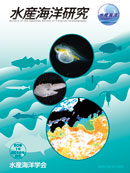Two Nematalosa species, N. japonica and N. come, are valuable target species for local fisheries in the Okinawan region of Japan. We examined the occurrence patterns, growth, osteological development, and feeding habits of two Nematalosa species collected from Nakagusuku Bay, Okinawa Island, Ryukyu Archipelago. Preflexion larvae first occurred in offshore areas and thereafter recruited to sandy tidal flats as they developed swimming abilities. The timing of recruitment to the sandy tidal flats occurred 10 days (10 mm) after the hatching of both species. Postflexion larvae and juveniles occurred mainly at sandy tidal flats and tidal mudflats, respectively. Metamorphosing larvae occurred in both habitats. These findings suggest that the larvae moved from sandy tidal flats to tidal mudflats during the metamorphosis phase. This phase is recognized as a semi-complete period in which swimming ability is attained, thus active movement can be assumed. The timing of this directed movement occurred ca. 30 days (15 mm) after hatching. The main food of larvae and juveniles (<22 mm) were calanoid copepods, and juveniles (>22 mm) began to feed on detritus. Juveniles inhabited and grew up in the tidal mudflats and adjacent shallow areas, and reached to ca. 100 mm one year after hatching. Shallow areas, especially tidal flats, are considered to be an important nursery area for larval and juvenile stage of these two Nematalosa species. Recent artificial environmental changes in Okinawa Island could reduce potential nursery areas for these species. Therefore, shallow habitats should be conserved to preserve the populations of the two species.
View full abstract
